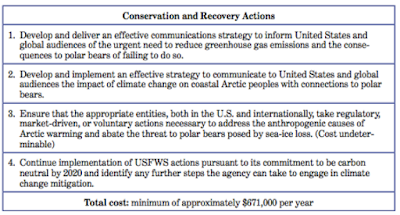Polar Bears
By Britney Moore
Polar Bears are one of the largest carnivores on land,
standing as high as eleven feet tall and can weight up to 1,400 lbs. These
k-selected mammals depend on floating ice as a stopping ground for hunting,
mating, and swimming long distances. They spend over 50% of their life hunting,
but only 2% of their hunts are successful. The primarily consume ringed and
bearded seals. Read more facts about polar bears here: http://www.defenders.org/polar-bear/basic-facts
Where are Polar Bears?
Polar
Bears are mainly in the artic and subarctic, with a total population of
22,000-25,000 bears. But with melting polar ice, there is a decline of ringed
seals (the main food source for polar bears). This causes the bears to swim
farther and exhaust more energy (and if they are mothers with young, FORGET
ABOUT IT). While the Polar Bear’s population seems to be steady, climate
change, habitat degradation, and over-harvesting are threats to the
conservation of these furry friends.
If there population
is steady, then why are they listed under the ESA?
Polar bears were listed under the ESA on July 8, 2015 as a
threatened species. They were listed because of the melting sea ice caused by
global warming. This melting sea ice, also affects polar bear's main prey; ringed seals. While currently the polar bear population is steady, if the
survival rate of female bears drops below 93%, then the reproductive rate would
decline in response.
So, help them!
In Alaska, the Marine Mammal Protection Act outlaws the “take”
of polar bears. There is also the Polar Bear Recovery Team to create a
Conservation Management Plan to work toward preserving polar bear’s habitat as
well as conserving this species. The current conservation plan is to manage
human-bear conflicts, protect denning habitat, minimize oil spills, support international
conservation efforts, and to do more monitoring and research.

What can the public
do?
WE, the public, can start in our home. Turn off your lights!
SO SIMPLE! Use natural light during the day; use a minimal amount at night and
simultaneously you will be reducing your electric bill! Awesome right? Well so
is car pulling… to work, to school, to go shopping, to anywhere you can! But
going beyond that, if you’re a teacher make an extra credit assignment for
students to write to a local politician to make local changes involving our
community and wildlife habitat. But if you’re not a teacher, write a letter
anyway! To a local politician, to state politician, or even to the president.
However, lets say you don’t enjoy writing but you still want to help. Start a
gofundme.org and advertise it! Once you reach your desired goal, donate it to
the recovery of polar bears.
References:




I never knew that their populations were steady. Interesting stuff!
ReplyDelete-Ramin Nazeri
#BIO227Fall2015